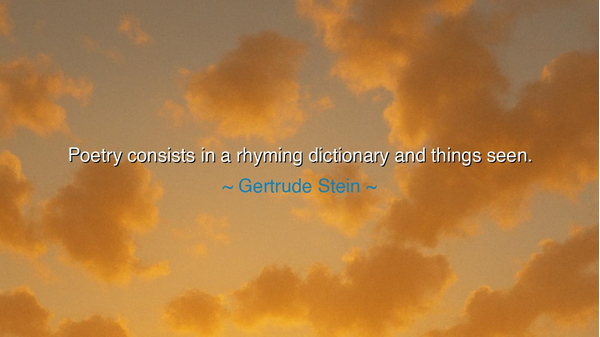
Poetry consists in a rhyming dictionary and things seen.






Hear the voice of Gertrude Stein, modernist and iconoclast, who declared: “Poetry consists in a rhyming dictionary and things seen.” At first, the words may sound playful, even dismissive, as though she reduces poetry to tools and fragments. Yet beneath the humor lies an ancient truth: poetry is born of two forces—the craft of language, with its forms, patterns, and rhymes, and the vision of life, the world as it appears to the attentive eye. Without both, poetry falters; with both, it becomes eternal.
The meaning is layered. The rhyming dictionary stands for discipline, for the labor of craft. Poetry is not only emotion poured onto the page, but structure shaped by skill. The poet must master rhythm, sound, and form, just as the mason masters stone. Yet this alone is insufficient. For what use is perfect rhyme without vision? Hence Stein adds the second force: things seen. The poet must open their eyes wide to the world—its colors, its sorrows, its daily miracles—and preserve them in words. Poetry arises when discipline meets perception, when craft weds vision.
Consider the haiku masters of Japan. Bash?, walking the narrow road to the deep north, saw frogs leaping into ancient ponds, saw the moonlight on quiet temples, saw travelers weary on the path. These were the things seen, simple yet profound. But he also bound them into strict syllables, measured with precision. His genius was not only in perception but in form. Without the rhyming dictionary—without discipline—the moment would have vanished; without the things seen, the poem would have been empty. With both, his poetry became timeless.
Stein’s remark also reflects her own rebellion against tradition. Living in the early twentieth century, she watched poetry shifting from classical rhyme toward free verse, from strict form toward experimentation. Her words remind us that even when rhyme falls away, the essence remains the same: sound shaped by discipline, life shaped by perception. Whether with rhyming couplets or fractured modern lines, the poet must still draw from these twin wells.
The lesson is eternal: to create poetry—or any art—one must balance craft and vision. Vision without craft is formless; craft without vision is lifeless. The young may write passionately but clumsily, and their work fades; the scholar may write perfectly but emptily, and their work rings hollow. But the true poet learns both—to see the world deeply and to shape words carefully, until the fleeting becomes permanent, and the ordinary becomes luminous.
In practical terms, if you wish to write poetry, train yourself in both directions. Practice form—meter, rhyme, structure—as a musician practices scales. This is your rhyming dictionary. But also walk in the world with eyes awake. Notice the turning of leaves, the sound of footsteps at dusk, the face of a stranger heavy with sorrow. These are your things seen. Then, bring the two together—discipline and vision, structure and wonder—and poetry will arise naturally.
Thus Stein’s words endure: “Poetry consists in a rhyming dictionary and things seen.” She teaches us that poetry is not mystery beyond reach, nor formula without soul, but the marriage of the inner craftsman and the outer witness. To read poetry is to taste this union; to write it is to embody it. And so, let all who aspire to poetry remember: learn the tools, open your eyes, and weave what you see into sound that endures beyond your own breath.






TDTuyet Dam
I think Stein is making an interesting point about simplicity. She strips poetry down to its two essentials: form and perception. The rhyming dictionary represents technique, while 'things seen' represents experience. It makes me wonder whether we overcomplicate poetry by searching for deeper meanings. Maybe, in her view, poetry isn’t about abstraction at all—it’s about translating the visible world through rhythm and pattern into something others can feel.
AHThu Anh Ha
This quote almost reads like a critique of how people approach poetry. It feels like Stein is pointing out the irony that anyone can technically write a poem if they have words and observations, but that doesn’t necessarily make it art. Maybe she’s commenting on how poetry depends as much on vision—how we see and interpret the world—as on craft. Without that personal seeing, rhyme alone feels empty.
BENguyen Van Binh Em
I’m not sure if Stein meant this ironically, but it definitely sounds like a challenge to traditional ideas of what poetry is. By mentioning a rhyming dictionary, she seems to downplay the romanticism of poetic creation. Maybe she’s reminding us that poetry isn’t some mystical art—it’s language, rhythm, and perception combined. Still, I wonder if that definition misses something—what about emotion, or the inner world of the poet?
GTGiang Tran
This statement feels very Gertrude Stein—playful but layered. At first it sounds almost dismissive, as if poetry could be reduced to rhyme and observation. But maybe she’s saying that poetry is about grounding creativity in the tangible world. 'Things seen' implies awareness, attention, and perspective. I like that—it reminds me that poetry isn’t just imagination or emotion, but also an act of noticing what others overlook.
DHNguyen Duy Hoang
I find this quote so delightfully concise—it captures both the craft and the perception behind poetry. The mention of a 'rhyming dictionary' feels like a nod to technique, while 'things seen' speaks to inspiration. It makes me wonder if Stein is poking fun at the tension between mechanical skill and genuine observation. Can poetry exist without one or the other? Maybe true poetry happens where structure meets perception.